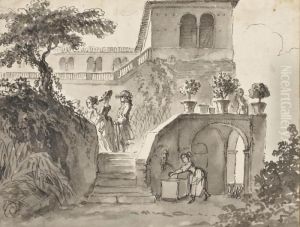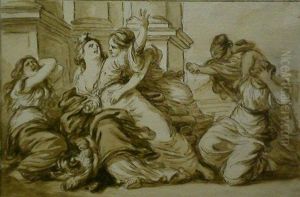Pierre Lelu Paintings
Pierre Lelu was a French painter, draftsman, and engraver born on September 20, 1744, in Paris. He was primarily known for his classical and historical subject matter, as well as for his landscape paintings. Lelu studied under the tutelage of Joseph-Marie Vien, a French painter who played a significant role in the neoclassical movement. Vien's influence is evident in Lelu's work, particularly in his approach to classical themes and his emphasis on linear clarity and balanced composition.
During his career, Pierre Lelu exhibited his work at the prestigious Paris Salon, a highly influential art exhibition in 18th-century France. His paintings often depicted scenes from ancient history and mythology, reflecting the neoclassical interest in antiquity that prevailed during the latter half of the 18th century. Lelu was also adept at creating landscapes imbued with a sense of tranquility and classical harmony, which were well-received by the art patrons of his time.
In addition to his painting, Lelu was skilled in engraving, which allowed him to reproduce his works as well as the works of others, thereby reaching a wider audience. His engravings, characterized by fine lines and attention to detail, contributed to the dissemination of neoclassical aesthetics.
Pierre Lelu's contributions to French art were recognized by his contemporaries, and he was admitted to the Académie Royale de Peinture et de Sculpture in 1774, which was an honor bestowed upon distinguished artists. Throughout his life, he continued to create and exhibit his art, leaving behind a legacy as a representative of neoclassical painting in France.
Lelu passed away on August 30, 1810, in Paris. Despite not being as widely remembered as some of his contemporaries, his work remains a testament to the neoclassical ideals of clarity, order, and the revival of classical themes in art during the Enlightenment period.



















